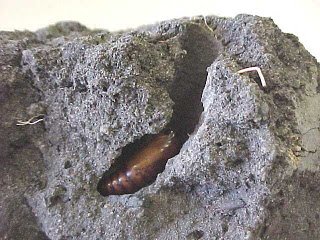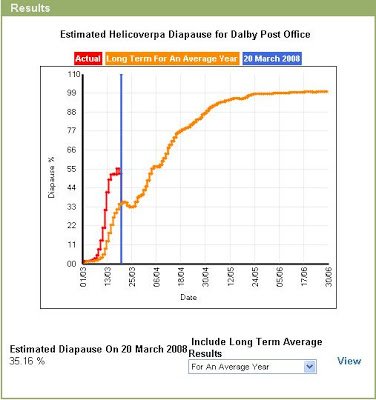While there was a hefty presence of corn earworn or cotton bollworm, Helicoverpa armigera, in the early and middle part of the 2007-08 season, pest activity has declined in recent weeks and for the most part they appear to pose no major risk.
What is diapause?
This is the time of the year when a proportion of mature larvae going to ground to pupate enter a hibernation phase termed diapause or overwintering. This dormancy strategy allows the pest to survive the winter months in temperate regions when host plants are scarce and temperatures are generally too low to allow successful development. The triggers to enter diapause are decreasing daylength and temperature as experienced during late summer and autumn.
The proportion of pupae entering diapause increases from low levels in March, to high levels, almost 100%, by late April. The rate of diapause induction varies from season to season, and region to region. Knowing when diapause is induced is useful for identifying ‘high risk’ fields i.e. those fields most likely to have diapausing pupae.
A web tool is available on the Cottassist website to help calculate the likely rate of diapause induction for your area, based on local climate data. The tool is also able to compare the results for the current season with the long term average and hotter than average and cooler than average seasons.
How are diapausing pupae controlled?
Overwintering pupae are very important because they contribute to the spring population and may take with them the resistance genes enabling them to tolerate conventional insecticides and the Bt transgenic toxins found in Bollgard II®.
It is for this reason that full soil surface cultivation to 10 cm depth (also known as pupae busting) is so important. When carried out properly, pupae busting can reduce survival of overwintering pupae to less than 5%.
Pupae busting is mandatory for all Bollgard II® fields; it is a requirement of the Bollgard II® licence.
Some relaxation of pupae busting requirements has been introduced for conventional cotton fields. Sprayed conventional cotton crops defoliated after 9 March are more likely to harbour insecticide resistant H. armigera pupae and should be pupae busted as soon as possible after picking and no later than the end of August.
The same holds true for the majority of grain crops on the Downs. Crops that were mature on or before 9 March are unlikely to harbour overwintering pupae. Conservation tillage (zero till or min-till) can be confidently used on these fields. Late season grain crops that could support development of larvae after 9 March are ‘high risk’ of harbouring overwintering pupae, and each field should be judged on its merits. The decision on whether to pupae bust will be influenced by the density of larvae present in the crop, the age of the larvae, and the timing of their presence in the crop.
Parasites will also influence survival of overwintering pupae, with estimates from a 5 year study on the Darling Downs showing 44% of overwintering pupae were parasitised. The two-toned caterpillar parasite, Heteropelma scaposum, was the most abundant parasite species recorded.
What is the current seasonal outlook for diapause in cotton and grain crops?
Output for the current season at Dalby, which is cooler than average, indicates a higher than average proportion of pupae have entered diapause.
All cotton crops, and a large proportion of the grain crops on the Downs, and in most other areas, will be harvested later than mid March. This means it is worth checking and recording whether these crops are hosting larvae that will diapause. Crops determined to be ‘high risk’ will warrant pupae busting.




are there any publications or resources that talk about genetic changes during diapause? I mean like gene frequencies and such info.